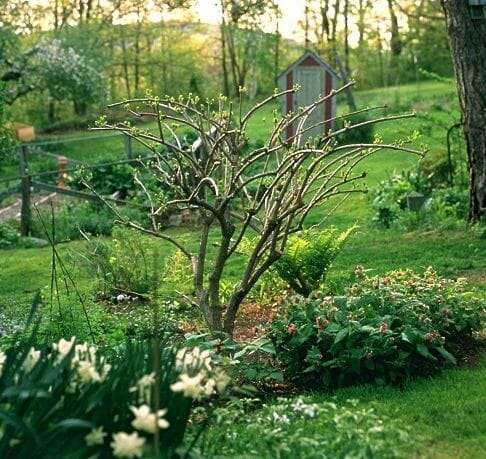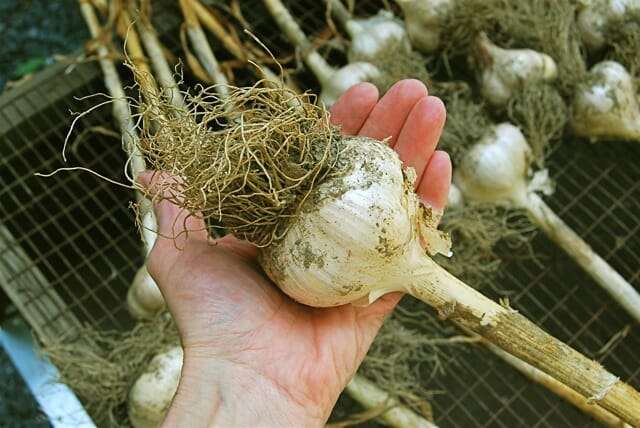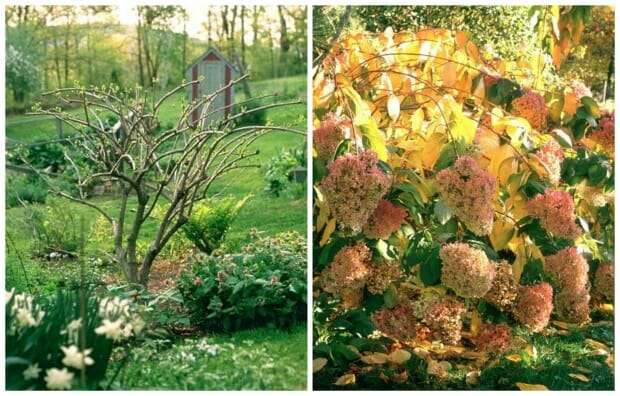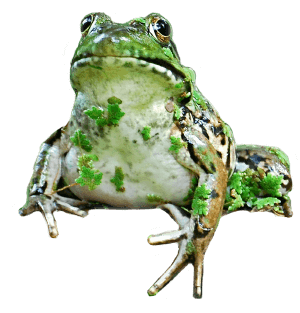q&a: pruning hydrangea, late planting, and more
 WONDERING HOW—and when—to prune Hydrangea paniculata shrubs whose blooms are browning off now as late fall takes hold? (That’s one sprouting after a light pruning in spring, above.) Or whether you can plant grocery-store-bought garlic and get a crop next year? These are among the recent questions you’ve asked, that I answered on this week’s edition of my public-radio show.
WONDERING HOW—and when—to prune Hydrangea paniculata shrubs whose blooms are browning off now as late fall takes hold? (That’s one sprouting after a light pruning in spring, above.) Or whether you can plant grocery-store-bought garlic and get a crop next year? These are among the recent questions you’ve asked, that I answered on this week’s edition of my public-radio show.
prefer the podcast?
I ANSWERED your most popular recent questions this week on the latest edition of the radio show, with the help of my sister, memoir-writing teacher Marion Roach Smith. You can listen anywhere, anytime: Locally, in my Hudson Valley (NY)-Berkshires (MA)-Litchfield Hills (CT) region, “A Way to Garden” airs on Robin Hood Radio’s three stations on Monday at 8:30 AM Eastern, with a rerun at 8:30 Saturdays. It is available free on iTunes, the Stitcher app, or streaming from RobinHoodRadio.com or via its RSS feed. The October 21, 2013 show can be streamed here now. Robin Hood is the smallest NPR station in the nation; our garden show marked the start of its fourth year in March, and is syndicated via PRX.
For a more detailed answer to each question, plus an extra question and answer or two, be sure to listen in. I’ve recapped the highlights below:
Q. I have some plants in my garage that still have to be planted. Is it too late? I’ve never planted this late before, but I just got too busy with my job.–Michelle in Canada (hardiness Zone 5B)
A. Yes—definitely get them in the ground, whether plunged (pots and all) or planted properly (removed from their pots first). I confess I often simply plunge things that are this late to getting in, using empty spaces in my vegetable garden and digging holes deep enough to accommodate the nursery pots, then putting a little soil over the lips as well.
Again: You can also simply plant them, unpotted, as you would at any other time. Be sure to tuck them in firmly.
Either way: Aftercare is important with the first few freezes, which tend to heave things up out of the ground—especially things that haven’t had enough time to root in well and resist the mechanical force of freezing and thawing.
So I go out and check them, and once the ground is frozen I pile on some mulch for good measure.
But definitely don’t leave them in your garage; better to give them insulation that the earth provides. Same with bulbs, by the way: Get them into the ground!

A. The trouble with planting grocery-store anything, to my mind, is two-fold:
- First, was it treated with any kind of retardant to inhibit sprouting, so it would stay “fresh” longer?
- Second, where was it grown, and is that farm’s climate and soil and so on similar to mine? (In other words: Is the supermarket variety that probably came from a farm in California really right for my Northeast garden?)
And therefore my answer is no, don’t plant supermarket garlic. Bulbs from the farmer’s market would more likely be fine on both counts, and I like to see the further designation that they have been grown organically. I either buy my “seed” garlic (the bulbs that I will divide into cloves and plant) from a local organic farmer or from a grower of certified organic “seed” garlic.

A helpful lawn guy pruned my shrub and this year I have tons of flowers all too close together and none able to grow to a decent size. There are too many stems. How to prune? And when? Do I take out whole branches to the main trunk?–Elayne
A. With Hydrangea paniculata, such as the so-called Pee Gee (short for paniculata ‘Grandiflora’) and ‘Tardiva’ and other panicle types, pruning requires a different thinking from blue-flowered moptop types, because paniculatas bloom on new wood.
Prune them in late winter or early spring, just before new growth begins. You can even prune in late fall, but I don’t like to do it until after winter has made its mess, in case branches are lost in storms, which would erase my earlier attempt at creating a good architecture.
They can be cut back quite hard, and still make new wood that then gets buds and blooms. Or you can skip pruning altogether, if you like. I know, that sounds counterintuitive–that you can choose to prune or skip it. They will sprout whether you prune or not, but depending what you do it will be on a smaller or larger plant, with fewer or more flower-producing stems.
Left on their own, many Hydrangea paniculata varieties would grow into small trees, with some up to 20 feet tall (10-plus feet is not uncommon).
As Elayne is experiencing: Not pruning, or pruning too little, will lead to a more twiggy, less-open plant that will produce many, smaller flowers. Generally, the harder you prune, fewer but larger blooms will be encouraged.
Where to place your cuts can be confusing. I have had specimens that I didn’t cut back enough turn to octopuses and really look a mess, and this is inclined to happen on older plants that have been cut back again and again to the same point. I’ve also cut old ones back too hard and had to suffer through some gawky recovery years.
The “secret,” if there is one: To get a good-shaped plant, you will often be pruning back to a mixture of oldest (thicker) wood and younger (last year’s) wood, and even some that’s in-between. The pruned structure will look odd, but try to think only in terms of creating a framework for emerging shoots that will then be topped with flowers. Your cuts indicate to the plant where it should (please!) sprout from. Let go of the fact that the wood you’re leaving will be of varying thicknesses.
Remember that these plants push lots of growth before blooming–like several feet or more–so they will be much bigger than the base architecture you created at pruning time. And as with any pruning project: First remove any damaged, inward-crossing or otherwise sub-standard stems—so that when you begin really shaping the plant, you know what you have to work with.
more answers to your questions!
- Investigate more Frequently Asked Questions (and answers!) at this link, on topics ranging from mulch and compost to seed starting and flower bulbs.





Can I ask another question? I have a honeysuckle plant that I want to move. Should I do it now, or wait until the spring? We’ve had several hard frosts (and the forecast calls for a low of 18F tonight!), but the leaves are still quite green, and not wilty/frostbitten. Many thanks!
Hi, Betsy. It probably will survive moving now, as long as the soil can be worked, but of course April-ish is even better.
i am generally in the no-prune camp with my hydrangeas, although there is always merit in cutting inward branches, as you say. but i always dead head, both to get some nice heads for a fall display, but also because i think this saves the plant energy. agree?
Margaret – your hydrangea post couldn’t come at a more opportune time! I cut some of the blooms this year to dry in the house. I usually only put in two inches of water so the blooms dry gradually. This year however, I put in way too much water. The blooms dried to a beautiful golden pink tone. But then I looked at the water level. Not only had the level remained high, the cuttings all sprouted roots!!!
My sister in law is eyeing these newly rooted babies! However, I am not quite sure what to do with them? It’s already November, and they’re defintely not hardy enough to put in the ground. Any suggestions? I would love to save these and see them planted next spring!
I have a friend who ate a sandwich while pruning a hydrangea, and promptly vomited profusely, a japanese friend said this was hydrangea poisoning which was well known in Japan – not known over here!
Last year I overwintered some division in pots in one of my veggie beds, which are always topped with several inches of fallen leaves in the fall. It was more or less an experiment. I didn’t know if they’d survive, but being leftovers after planting some here and giving some away, and being too busy/lazy to dig them in (plus the ground was frozen by that time) I just placed the pots on top of the soil and insulated the pots with all those leaves between, and on top of them. It worked – they all survived. I’m doing it again this year. Hopefully they will all survive again, but if not . . . oh well – there are more where they came from. I wouldn’t do this with purchased plants or plants I absolutely didn’t want to lose, but I’m taking the chance again this year mainly to see how well it will work again. and because I’m too lazy and once again the ground is frozen. ;)
divisions
I am still awaiting shrubs that I ordered from the Arbor Day Foundation months ago. They advise fall planting and I was a little late for spring so I took their advice. Had I known that they were going to send plants in late November, I would have taken my chances! Now I’m wondering if I should contact them and put it off until spring. I’m in the Hudson Valley, zone 6a, I would appreciate any thoughts.
i enjoy the decaying flowers of my paniculata “limelight” thru the winter – texture, movement – pretty in the snow – and then prune rather hard anytime before growing begins – sometimes after …. they are tough plants. i prune mine so that i get more and smaller flowers – unpruned they are just too large to be useful for my cut flower business . i’ve also begun to leave the other variety of hydrangea flowers on the shrubs thru winter for the pleasure of the form – nice to see something round amongst the bare branches and twigs – prefer to prune in spring when buds are swelling and the dead branches are easier to spot
Me, too, Cinda — I wait, though sometimes I take off the brown flowerheads when they are really shot, because they blow off and all over the place here on my many big plants! :)
I tried store-bought garlic a number of years ago, with absolutely no success. Not surprising, seeing as garlic here in Nova Scotia mostly comes from China. Last year, I planted organic garlic from a local farmer’s outlet. Huge success! But I didn’t plant nearly enough to satisfy my needs (only 12 cloves which became 12 gorgeous large heads), and I harvested a bit too late (the cloves were not tightly wrapped). This year: 24 cloves from newly purchased garlic (same farmer’s outlet) plus 4 cloves from my harvest. Let’s see what does best in June 2014!
If I may pass my experience on to jmacncheese, I have ordered trees from Arborday before (also zone 6a in Oklahoma) and didn’t get them till November. I was unable to get them in their permanent places that late in the year so I planted them in pots, lined the pots up against the south wall of my house (it’s brick and therefore holds some warmth), filled the spaces between with leaves and hay and then surrounded all the edges with bagged leaves. Most of them made it through the winter and the planting process during the following spring. One thing about my Arborday order, though, was that the apple trees and peach tree, once they made fruit, turned out not to be the variety advertised. Not sure about the plum trees as they have not made any fruit yet. I took their free flowering trees and the golden rain and dogwood trees did not make it through the summer, even with extra watering because of the drought.
Thanks, Ilene. Sounds like quite the mixed experience with that order!
Ilene, thank you so much for your comments. Potting them up sounds like a good plan. We are having a warm wet spell right now, but don’t think it will last long enough to get the shrubs in the ground. Must have been a little discouraging to get the wrong variety of fruit tree. I asked them not to send the free flowering shrub – forsythia!
HI Margaret – Everyone around me has their landscapers blowing out leaves from their gardens and lawns. I like to leave the fallen leaves on my garden (but mow them from the lawn) as a layer of protection in the winter and also in hopes of some decomposition to help the soil in the spring. Is this a bad idea? Should I be removing every last leaf now too? Or can I wait until spring? Thanks!
Hi, Kate. I prefer to remove them to the compost heap, preferable run over by the lawn mower or otherwise pre-shredded, to break down there before using them in the beds. I find that whole leaves matted down on my beds and borders can invite rodents and other little pests to scurry around in winter, and if the winter lingers into April or whenever, some of the plants trying to push up are under a wet blanket. So I move them now, but never waste and single one.
I was so happy to read your advice on pruning the hydrangeas. I have a PG hydrangea that is over 20 years old and more than 15 feet tall. I cut blossoms for drying each fall but the plant has gotten so tall I can’t reach the best blooms. I was toying with a hard pruning next spring and now you’ve given me the courage to do it. I’ve gotten so much good advice (and wonderful recipes) from you. Thanks for all your hard work.
Hi, I’m gardening in Mid-coast Maine. I’ve been planting garlic for many years and have just learned the “correct”way! I grow enough garlic, about 100 bulbs, to plant my next garlic crop from my harvest. In the Fall, Oct. where I am, I break apart all my heads of garlic, and plant single cloves in a bed with good compost/manure about 3″ deep (with the pointy end up) and about 4” apart. The great thing about garlic, is that in the spring when there are a million things to plant, the garlic is already in the ground!
Summertime brings on the Scapes, the “piggy tails” which I cut and chop up for soups, stir-fries, or if your’e an Herbalist like me, you can tincture the scapes for a great antibiotic. Some say that if you leave the scapes the bulbs will be smaller. If you leave a couple of scapes and the seeds drop, then you’ll have garlic from those seeds in 2 yrs. Then in summer, August for us, when the top 2-3 leaves turn brown is the time to dig it all up, I use a pitch fork. I barely brush off dirt and don’t cut the stems, let them dry on a sheet out in the yard for the day and then I move them into my studio and lay them on drying racks for a couple of weeks. Then you take off outside skins to reveal that beautiful delicious healthy rosy bulb! If the garlic stays in the ground too long, like all the leaves are brown, then you are losing those extra skins and the cloves spread apart. My 100 garlic cloves are snug in their winter beds and I keep my harvested garlic in the basement (cool) in paper bags.
Sounds as if you have it nailed, Susan. Love growing garlic!
Hi Margaret I have a question. I live in new jersey zone 6. I purchased a hydranga from a nursery its pink and he planted it in full sun so when it bloomed the flowers turned brown I would like to transplant it into a 1/2 barrell where it will get morning sun and some shade…My question is when shoud I move it and is planting it in a barrell ok…
Hi, Billie. Is it a mop-top variety — with big round flowerheads like you often see in the color blue — or a paniculata type like the one in the photo? All of the hydrangea flowers will turn tan and brown as they age each season (though not right away!), whether in sun or shadier spots, and will bloom more heavily in sun. Yes, you can put it in a barrel if the pot is big enough to insulate the roots well in winter, and big enough for the plant in general. It would be best to get a dwarf-ish variety instead of one of the ones that wants to be very large if you plan to confine it to a pot, of course.